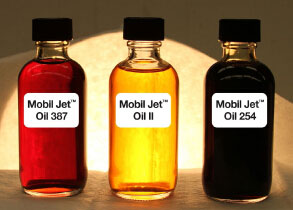Introduction
The color of gas-turbine oils is due to the additive package selected for the product.
Color will vary between oils and it is not an indicator of oil quality or suitability. An oil's color should not be judged by light reflected from a sample, instead, the sample should be tilted to allow the color of light transmitted through a film of the oil to be assessed.
Color Changes
The color of the oil will change during normal engine operation when additives do their job of protecting the base stock. Such changes do not affect the performance of the oil and do not indicate contamination or other malfunction.
Excessive Discoloration
Excessive discoloration can occur due to higher than normal local temperatures in the engine or due to contaminants in the system. Such high temperatures can originate during an engine failure due, for example, to frictional heat or seal failure.
Contaminants such as hydraulic fluid or other lower stability fluids can promote severe oil discoloration and engine deposits.
Black Oil
The phenomenon referred to as "black oil" is not due to oil discoloration but to the suspension of very small amorphous particles in the oil. When the particles are filtered from the oil, the color reverts to normal. Black oil arises in certain engines due to an artifact of the engine design. It cannot be eliminated by oil development or reformation.
Summary
(1) Some oil discoloration is normal in engine use of gas turbine oils.
(2) The extent of discoloration will vary with the oil in use and the severity of the engine.
(3) Excessive discoloration can indicate engine problems or contamination.
(4) Black oil is not an oil problem; it arises due to specific engine conditions.




